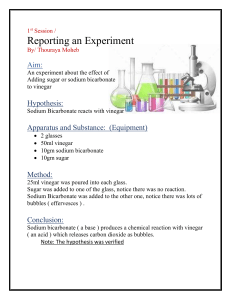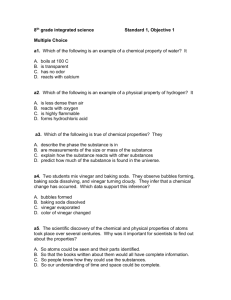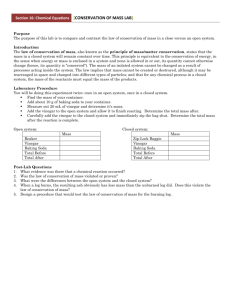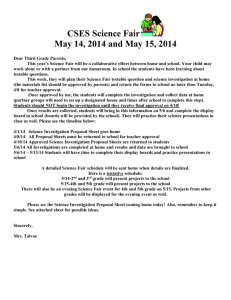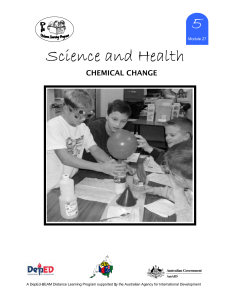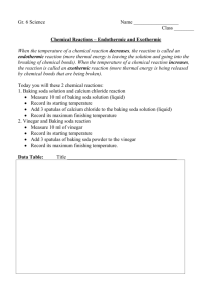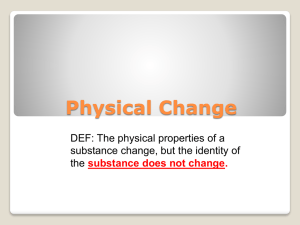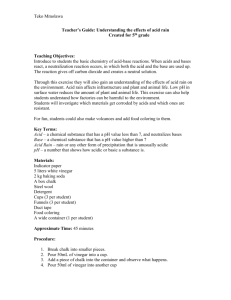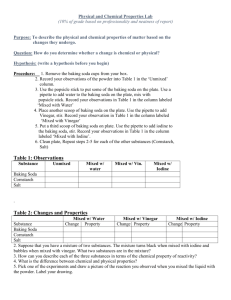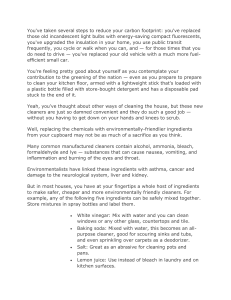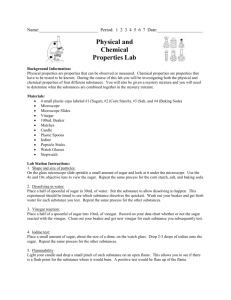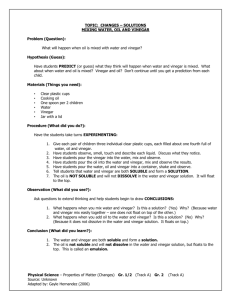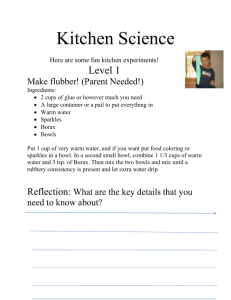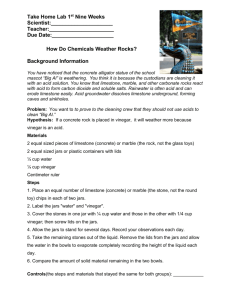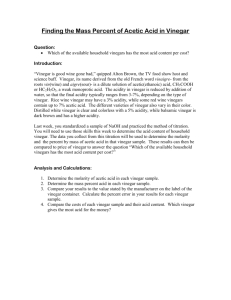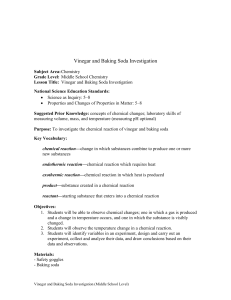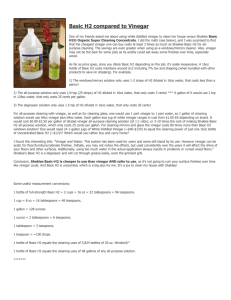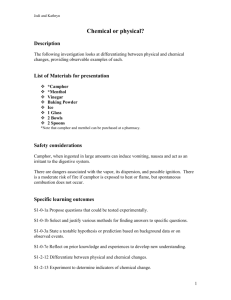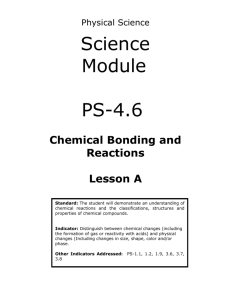Physical and Chemical Test Tube Stations Answer Key
advertisement
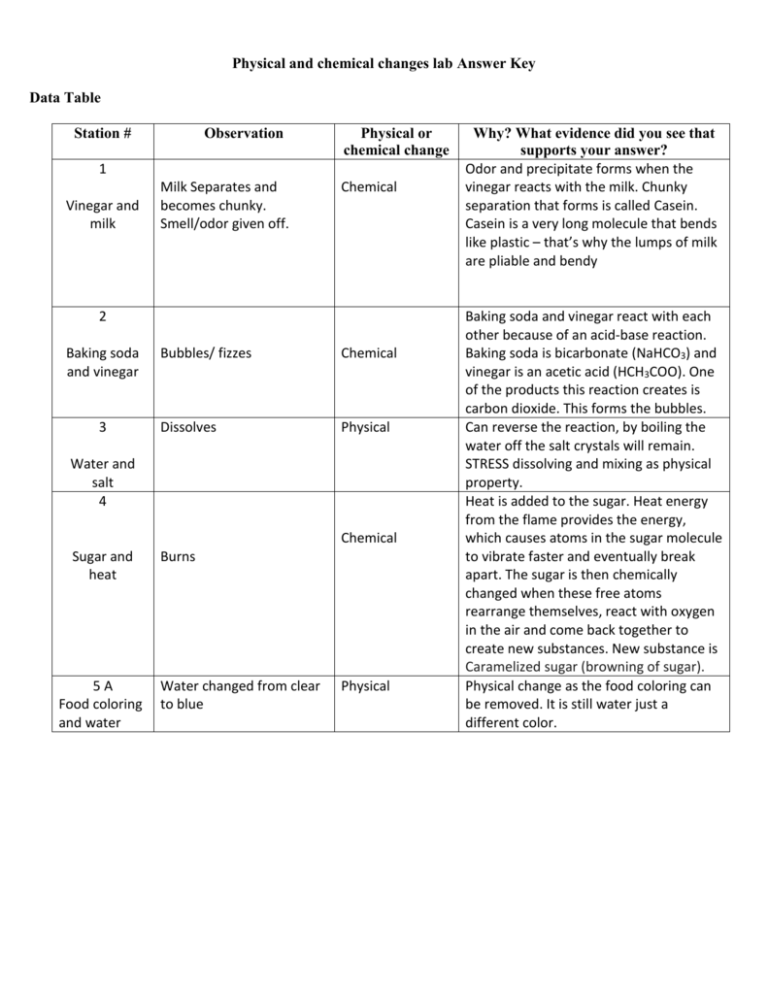
Physical and chemical changes lab Answer Key Data Table Station # Observation Physical or chemical change 1 Vinegar and milk Milk Separates and becomes chunky. Smell/odor given off. Chemical 2 Baking soda and vinegar 3 Bubbles/ fizzes Chemical Dissolves Physical Water and salt 4 Chemical Sugar and heat 5A Food coloring and water Burns Water changed from clear to blue Physical Why? What evidence did you see that supports your answer? Odor and precipitate forms when the vinegar reacts with the milk. Chunky separation that forms is called Casein. Casein is a very long molecule that bends like plastic – that’s why the lumps of milk are pliable and bendy Baking soda and vinegar react with each other because of an acid-base reaction. Baking soda is bicarbonate (NaHCO3) and vinegar is an acetic acid (HCH3COO). One of the products this reaction creates is carbon dioxide. This forms the bubbles. Can reverse the reaction, by boiling the water off the salt crystals will remain. STRESS dissolving and mixing as physical property. Heat is added to the sugar. Heat energy from the flame provides the energy, which causes atoms in the sugar molecule to vibrate faster and eventually break apart. The sugar is then chemically changed when these free atoms rearrange themselves, react with oxygen in the air and come back together to create new substances. New substance is Caramelized sugar (browning of sugar). Physical change as the food coloring can be removed. It is still water just a different color. Station # 5B Observation Blue water returned to clear color Physical or chemical? Chemical Food coloring, water and bleach 6 Temperature goes up, brown mixture appears Chemical Foam disappeared Chemical Hydrogen peroxide and yeast 7 Why? What evidence did you see that supports your answer? Bleach contains sodium hypochlorite, which is an oxidizer. It oxidizes or reacts with the color molecules in food coloring. Although the pigment molecule remains, its shape changes so that it can't absorb/reflect light the same way, so it loses its color as a result of the chemical reaction. Exothermic reaction – heat is given off so temperature goes up. The vinegar reacts with the yeast, forming carbon dioxide bubbles causing the yeast to “grow” Magic paper 8 Foam and acetone 9 Chemical Steel wool and vinegar Steel wool changed brown color 10 Chemical Potato and iodide Potato turned dark blue 11 Chemical Glow stick 12 Glows Physical Kool-Aid and water Changes color A new substance is formed, as a goo like substance is left behind. Vinegar is reacting with steel wool causing it to rust. Rusting (or oxidation) is a chemical reaction between iron and oxygen, this chemical reaction creates heat energy which increases the temperature inside the beaker. This experiment is an example of an exothermic reaction, a chemical reaction that releases energy in the form of heat. The reason why it turns dark blue is because the iodine combines with the starch in the potato. The reaction between the different compounds in a light stick causes a release of energy and the stick glows. Mixing Kool-Aid is a physical change since you are just dissolving the components in water. If you could evaporate all of the water, you would be left with the same stuff you started with. Explain/Evaluate Answer the following questions: 1. In which of the experiments were new substances formed? ____________________________________________________________________________ ____________________________________________________________________________ 2. How were you able to tell the difference between physical and chemical changes? ____________________________________________________________________________ ____________________________________________________________________________ 3. It maybe confusing to recognize the difference between physical and chemical changes. Give two examples. ____________________________________________________________________________ ____________________________________________________________________________ ____________________________________________________________________________ 4. Does the mass of the ingredients change during physical changes? What about during chemical changes? ____________________________________________________________________________ ____________________________________________________________________________ 5. In one of today’s experiments, you made a mixture where the ingredients kept their physical properties. Which experiment was it? ____________________________________________________________________________ ____________________________________________________________________________ 6. If you wanted to learn more about all the physical changes possible for water, what three states of matter would you study? ____________________________________________________________________________ ____________________________________________________________________________ Evidence - What is the proof? (Go back to data table and give three examples of evidence of chemical changes.) ____________________________________________________________________________ ____________________________________________________________________________ ____________________________________________________________________________ ____________________________________________________________________________ ____________________________________________________________________________ ____________________________________________________________________________

